1920 APFA season
The 1920 APFA season was the inaugural season of the American Professional Football Association, renamed the National Football League in 1922. An agreement to form a league was made by four independent teams from Ohio on August 20, 1920, at Ralph Hay's office in Canton, Ohio, with plans to invite owners of more teams for a second meeting on September 17. [1] The "American Professional Football Conference" (APFC) was made up of Hay's Canton Bulldogs, Akron Pros, the Cleveland Tigers and the Dayton Triangles, who decided on a six-game scheduled to play each other at home-and-away, an agreement to respect each other's player contracts, and to take a stand against signing college students whose class had not yet graduated. [2][3]
| Regular season | |
|---|---|
| Duration | September 26 – December 19, 1920 |
| Champions | Akron Pros |
A second organizational meeting was held in Canton on September 17, with the original four APFC clubs, as well as a fifth Ohio team that had played informally in what historians later dubbed the "Ohio League" (the Columbus Panhandles) and four teams from Illinois (Chicago Cardinals and Chicago Tigers, Decatur Staleys, and Rock Island Independents), two from Indiana (Hammond Pros and Muncie Flyers), two from New York (Buffalo All-Americans and Rochester Jeffersons), and the Detroit Heralds from Michigan for a total of 14. At the meeting, the name of the league became the American Professional Football Association. Four other teams also joined the Association during the year. Meanwhile, Jim Thorpe of the Canton Bulldogs was named the APFA's first president but continued to play for the team.
Scheduling was left up to each team. There were wide variations, both in the overall number of games played and in the number played against other Association members. Thus, no official standings were maintained. In addition, football teams in the APFA also faced independent football teams not associated with the league. For instance, the Rochester Jeffersons played a schedule consisting mostly of local teams from their local sandlot circuit and the NYPFL, not the APFA.
The Akron Pros ended the season as the only undefeated team in the Association. Despite this, two one-loss teams, the Decatur Staleys and Buffalo All-Americans, who both tied Akron that year, made cases for a co-championship.
At the league meeting in Akron on April 30, 1921, the Pros were awarded the Brunswick-Balke Collender Cup for the 1920 season, the only year the trophy was used.
If modern NFL tie-breaking rules were in force in 1920, the Buffalo All-Americans (9–1–1) would have been co-champions with the Akron Pros (8–0–3), as both had a win percentage of .864 and their only game was tied, while the Staleys (10–1–2) would have finished third with .846.
Further, if games against non-APFA teams were excluded, Akron (6–0–3) would still have won the championship with .833, but the All-Americans (4–1–1) and the Staleys (5–1–2) would finish equal second with .750 as they did not play each other.
Of the 14 teams that played in the APFA/NFL's inaugural season, the Chicago Cardinals, now known as the Arizona Cardinals, and the Decatur Staleys, now known as the Chicago Bears, are the only teams that remain in the league.[4]
Formation
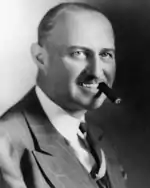
Prior to the APFA, there were several other loose, professional organizations; most of the APFA teams were from either the Ohio League or the New York Pro Football League. On August 20, 1920, a meeting attended by representatives of four Ohio League teams—Ralph Hay and Jim Thorpe for the Canton Bulldogs, Jimmy O'Donnell and Stan Cofall for the Cleveland Tigers, Carl Storck for the Dayton Triangles, and Frank Nied and Art Ranney for the Akron Pros[5]—was held. At the meeting, the representatives tentatively agreed to call their new league the American Professional Football Conference, introduce a salary cap for the teams, and not to sign college players nor players under contract with another team.[6][7] According to the Canton Evening Repository, the purpose of the league was to "raise the standard of professional football in every way possible, to eliminate bidding for players between rival clubs and to secure cooperation in the formation of schedules, at least for the bigger teams."[8] The representatives then contacted other major professional teams and invited them to a meeting for September 17.[9]
At that meeting, held at Bulldogs owner Ralph Hay's Hupmobile showroom in Canton, Ohio, representatives of the Rock Island Independents, the Muncie Flyers, the Decatur Staleys, the Racine Cardinals, the Massillon Tigers, the Chicago Tigers, and the Hammond Pros agreed to join the league. Representatives of the Buffalo All-Americans and Rochester Jeffersons could not attend the meeting, but sent letters to Hay asking to be included in the league.[10] Team representatives changed the league's name slightly to the American Professional Football Association and elected officers, installing Thorpe as president, Cofall as vice-president, Ranney as secretary-treasurer.[5][10][11][12] Under the new league structure, teams created their schedules dynamically as the season progressed, so there were no minimum or maximum number of games needed to be played.[13][14] Also, representatives of each team voted to determine the winner of the APFA trophy.[15]
Teams
The APFA had 14 teams that played during its inaugural season.
| Team folded this season ^ |
| Team | Head coach(es)[16] | Stadium(s)[17] |
|---|---|---|
| Akron Pros | Elgie Tobin | Akron League Park |
| Buffalo All-Americans | Tommy Hughitt | Canisius Field and Buffalo Baseball Park |
| Canton Bulldogs | Jim Thorpe | Lakeside Park |
| Chicago Cardinals | Paddy Driscoll | Normal Park |
| Chicago Tigers ^ | Guil Falcon | Cubs Park |
| Cleveland Tigers | Stan Cofall (3 games) and Al Pierotti (5 games) | Dunn Field |
| Columbus Panhandles | Ted Nesser | Neil Park |
| Dayton Triangles | Bud Talbott | Triangle Park |
| Decatur Staleys | George Halas | Staley Field |
| Detroit Heralds | Billy Marshall | Navin Field |
| Hammond Pros | Hank Gillo | Traveling team |
| Muncie Flyers | Ken Huffine | Traveling team |
| Rochester Jeffersons | Jack Forsyth | Rochester Baseball Park |
| Rock Island Independents | Rube Ursella | Douglas Park |
Schedule
The regular-season schedule was not fixed but was created dynamically by each team as the season progressed.[13][14] The first game involving an APFA team occurred on September 26, when the Rock Island Independents beat the St. Paul Ideals 48–0.
The first official game between APFA (NFL) members occurred on October 3, when the Dayton Triangles beat the Columbus Panhandles 14-0. The Triangles' Lou Partlow scored the league's first touchdown and George "Hobby" Kinderline kicked the first extra point. A historic marker placed by the Ohio Historical Society at Triangle Park in Dayton marks the location of that first ever game.[18]
The final game of the season was a 14–14 tie between the Chicago Cardinals and the non-league Chicago Stayms on December 19, 1920. The Decatur Staleys and the Canton Bulldogs played the most games in the season (13), while the Muncie Flyers played the fewest (1).[19] The Buffalo All-Americans scored the most points all season (258), and the Akron Pros allowed the fewest points (7).[20]
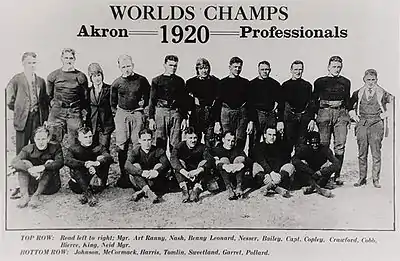
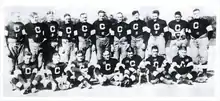
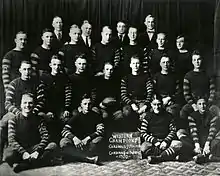

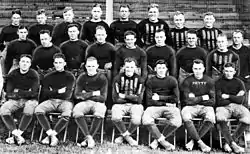
| Symbol | Meaning |
|---|---|
| Non-APFA team | |
| (numbers in parentheses) | Team's win-loss-tie record |
| Week 1 | |||||||
| September 26, 1920 | |||||||
|---|---|---|---|---|---|---|---|
| Visitor | Score | Home | Score | Location | |||
| St. Paul Ideals | 0 | Rock Island Independents (1–0–0) | 48 | Douglas Park | |||
| Week 2 | |||||||
| October 3, 1920 | |||||||
| Wheeling Stogies | 0 | Akron Pros (1–0–0) | 43 | Akron League Park | |||
| West Buffalo | 6 | Buffalo All-Americans (1–0–0) | 32 | Canisius Field | |||
| Pitcairn Quakers | 0 | Canton Bulldogs (1–0–0) | 48 | Lakeside Park | |||
| Columbus Panhandles (0-1–0) | 0 | Dayton Triangles (1–0–0) | 14 | Triangle Park | |||
| Moline Universal Tractors | 0 | Decatur Staleys (1–0–0) | 20 | Staley Field | |||
| Muncie Flyers (0–1–0) | 0 | Rock Island Independents (2–0–0) | 45 | Douglas Park | |||
| All-Buffalo | 0 | Rochester Jeffersons (1–0–0) | 10 | Rochester Baseball Park | |||
| Week 3 | |||||||
| October 10, 1920 | |||||||
| Columbus Panhandles (0–2–0) | 0 | Akron Pros (2–0–0) | 37 | Akron League Park | |||
| All-Buffalo | 0 | Buffalo All-Americans (2–0–0) | 51 | Canisius Field | |||
| Toledo Maroons | 0 | Canton Bulldogs (2–0–0) | 42 | Lakeside Park | |||
| Racine Cardinals (0–0–1) | 0 | Chicago Tigers (0–0–1) | 0 | Cubs Park | |||
| Cleveland Tigers (0–0–1) | 0 | Dayton Triangles (1–0–1) | 0 | Triangle Park | |||
| Kewanee Walworths | 7 | Decatur Staleys (2–0–0) | 25 | Staley Field | |||
| Cleveland Panthers | 14 | Detroit Heralds (1–0–0) | 40 | Mack Park | |||
| Hammond Pros (0–1–0) | 0 | Rock Island Independents (3–0–0) | 26 | Douglas Park | |||
| Fort Porter | 0 | Rochester Jeffersons (2–0–0) | 66 | Rochester Baseball Park | |||
| Week 4 | |||||||
| October 17, 1920 | |||||||
| Cincinnati Celts | 0 | Akron Pros (3–0–0) | 13 | Akron League Park | |||
| McKeesport Olympics | 7 | Buffalo All-Americans (3–0–0) | 28 | Canisius Field | |||
| Cleveland Tigers (0–1–1) | 0 | Canton Bulldogs (3–0–0) | 7 | Lakeside Park | |||
| Moline Universal Tractors | 3 | Racine Cardinals (1–0–1) | 33 | St. Rita's Field | |||
| Detroit Heralds (1–1–0) | 0 | Chicago Tigers (1–0–1) | 12 | Cubs Park | |||
| Columbus Panhandles (0–3–0) | 0 | Fort Wayne Friars | 14 | Fort Wayne League Park | |||
| Hammond Pros (0–2–0) | 0 | Dayton Triangles (2–0–1) | 44 | Triangle Park | |||
| Decatur Staleys (3–0–0) | 7 | Rock Island Independents (3–1–0) | 0 | Douglas Park | |||
| Utica Knights of Columbus | 0 | Rochester Jeffersons (2–0–1) | 0 | Rochester Baseball Park | |||
| Week 5 | |||||||
| October 24, 1920 | |||||||
| Cleveland Tigers (0–2–1) | 0 | Akron Pros (4–0–0) | 7 | Akron League Park | |||
| Toledo Maroons | 0 | Buffalo All-Americans (4–0–0) | 38 | Canisius Field | |||
| Canton Bulldogs (3–0–1) | 20 | Dayton Triangles (2–0–2) | 20 | Triangle Park | |||
| Racine Cardinals (1–1–1) | 0 | Rock Island Independents (4–1–0) | 7 | Douglas Park | |||
| Decatur Staleys (4–0–0) | 10 | Chicago Tigers (1–1–1) | 0 | Cubs Park | |||
| Columbus Panhandles (0–4–0) | 0 | Detroit Heralds (2–1–0) | 6 | Mack Park | |||
| Syracuse Stars | 7 | Rochester Jeffersons (3–0–1) | 21 | Rochester Baseball Park | |||
| Week 6 | |||||||
| October 31, 1920 | |||||||
| Akron Pros (5–0–0) | 10 | Canton Bulldogs (3–1–1) | 0 | Lakeside Park | |||
| Rochester Jeffersons (3–1–1) | 6 | Buffalo All-Americans (5–0–0) | 17 | Canisius Field | |||
| Detroit Heralds (2–2–0) | 0 | Racine Cardinals (2–1–1) | 21 | Cubs Park | |||
| Chicago Tigers (1–2–1) | 7 | Rock Island Independents (5–1–0) | 20 | Douglas Park | |||
| Columbus Panhandles (0–5–0) | 0 | Cleveland Tigers (1–2–1) | 7 | Dunn Field | |||
| Cincinnati Celts | 7 | Dayton Triangles (3–0–2) | 23 | Triangle Park | |||
| Decatur Staleys (5–0–0) | 29 | Rockford A.C. | 0 | Kishwaukee Park | |||
| Hammond Pros (1–2–0) | 14 | Logan Square | 9 | Logan Square Park | |||
| Week 7 | |||||||
| November 7, 1920 | |||||||
| All-Tonawanda Lumberjacks | 0 | Buffalo All-Americans (6–0–0) | 35 | Canisius Field | |||
| Canton Bulldogs (4–1–1) | 18 | Cleveland Tigers (1–3–1) | 0 | Dunn Field | |||
| Racine Cardinals (3–1–1) | 6 | Chicago Tigers (1–3–1) | 3 | Cubs Park | |||
| Columbus Panhandles (1–5–0) | 10 | Zanesville Mark Grays | 0 | Zanesville, Ohio | |||
| Decatur Staleys (5–0–1) | 0 | Rock Island Independents (5–1–1) | 0 | Douglas Park | |||
| Hammond Pros (2–2–0) | 14 | Pullman Thorns | 13 | Chicago, Illinois | |||
| Utica Knights of Columbus | 7 | Rochester Jeffersons (4–1–1) | 27 | Rochester Baseball Park | |||
| Week 8 | |||||||
| November 11, 1920 | |||||||
| Decatur Staleys (6–0–1) | 20 | Champaign Legion | 0 | Champaign, Illinois | |||
| Rock Island Independents (5–1–2) | 7 | Thorn Tornadoes | 7 | Monmouth, Illinois | |||
| November 14, 1920 | |||||||
| Akron Pros (5–0–1) | 7 | Cleveland Tigers (1–3–2) | 7 | Dunn Field | |||
| Columbus Panhandles (1–6–0) | 7 | Buffalo All-Americans (7–0–0) | 43 | Canisius Field | |||
| Chicago Tigers (1–4–1) | 0 | Canton Bulldogs (5–1–1) | 21 | Lakeside Park | |||
| Cincinnati Celts | 0 | Racine Cardinals (4–1–1) | 21 | Chicago, Illinois | |||
| Dayton Triangles (4–0–2) | 21 | Rock Island Independents (5–2–2) | 0 | Douglas Park | |||
| Decatur Staleys (7–0–1) | 3 | Minneapolis Marines | 0 | Nicollet Park | |||
| Detroit Heralds (2–2–1) | 0 | Fort Wayne Friars | 0 | Fort Wayne League Park | |||
| Hammond Pros (2–3–0) | 6 | Gary Elks | 7 | Gleason Field | |||
| All-Tonawanda Lumberjacks | 6 | Rochester Jeffersons (4–2–1) | 0 | Rochester Baseball Park | |||
| Week 9 | |||||||
| November 21, 1920 | |||||||
| Dayton Triangles (4–1–2) | 0 | Akron Pros (6–0–1) | 13 | Akron League Park | |||
| Canton Bulldogs (6–1–1) | 3 | Buffalo All-Americans (7–1–0) | 0 | Canisius Field | |||
| Lansing Oldsmobile | 0 | Racine Cardinals (5–1–1) | 14 | Chicago, Illinois | |||
| Toledo Maroons | 0 | Cleveland Tigers (2–3–2) | 14 | Dunn Field | |||
| Columbus Panhandles (1–6–1) | 0 | Zanesville Mark Grays | 0 | Zanesville, Ohio | |||
| Hammond Pros (2–4–0) | 7 | Decatur Staleys (8–0–1) | 28 | Staley Field | |||
| Rochester Scalpers | 0 | Rochester Jeffersons (5–2–1) | 16 | Rochester Baseball Park | |||
| Week 10 | |||||||
| November 25, 1920 | |||||||
| Canton Bulldogs (6–2–1) | 0 | Akron Pros (7–0–1) | 7 | Akron League Park | |||
| Decatur Staleys (9–0–1) | 6 | Chicago Tigers (1–5–1) | 0 | Chicago Cub Park | |||
| Columbus Panhandles (1–6–2) | 0 | Elyria Athletics | 0 | Lorain, Ohio | |||
| Detroit Heralds (2–3–1) | 0 | Dayton Triangles (5–1–2) | 28 | Triangle Park | |||
| Hammond Pros (2–5–0) | 0 | Chicago Boosters | 27 | DePaul Field | |||
| All-Tonawanda Lumberjacks | 14 | Rochester Jeffersons (5–3–1) | 3 | Rochester Baseball Park | |||
| November 28, 1920 | |||||||
| Akron Pros (8–0–1) | 14 | Dayton Triangles (5–2–2) | 0 | Triangle Park | |||
| Cleveland Tigers (2–4–2) | 0 | Buffalo All-Americans (8–1–0) | 7 | Buffalo Baseball Park | |||
| Decatur Staleys (9–1–1) | 6 | Racine Cardinals (6–1–1) | 7 | Normal Park | |||
| Thorn Tornadoes | 0 | Chicago Tigers (2–5–1) | 27 | Cubs Park | |||
| Lansing Oldsmobile | 0 | Detroit Heralds (2–3–2) | 0 | Mack Park | |||
| Rochester Scalpers | 6 | Rochester Jeffersons (6–3–1) | 7 | Rochester Baseball Park | |||
| Pittsburgh All-Collegians | 7 | Rock Island Independents (6–2–2) | 48 | Douglas Park | |||
| Week 11 | |||||||
| December 4, 1920 | |||||||
| Canton Bulldogs (6–3–1) | 3 | Buffalo All-Americans (9–1–0) | 7 | New York Polo Grounds | |||
| December 5, 1920 | |||||||
| Akron Pros (8–0–2) | 0 | Buffalo All-Americans (9–1–1) | 0 | Buffalo Baseball Park | |||
| Canton Bulldogs (6–3–2) | 0 | Washington Glee Club | 0 | New Haven, Connecticut | |||
| Racine Cardinals (6–2–1) | 0 | Decatur Staleys (10–1–1) | 10 | Cubs Park | |||
| Columbus Wagner Pirates | 0 | Columbus Panhandles (2–6–2) | 24 | Neil Park | |||
| Detroit Maroons | 7 | Detroit Heralds (2–3–3) | 7 | Mack Park | |||
| Rochester Scalpers | 0 | Rochester Jeffersons (6–3–2) | 0 | Exposition Park | |||
| Week 12 | |||||||
| December 11, 1920 | |||||||
| Canton Bulldogs (6–4–2) | 7 | Union Club of Phoenixville | 13 | Phillies Park | |||
| December 12, 1920 | |||||||
| Akron Pros (8–0–3) | 0 | Decatur Staleys (10–1–2) | 0 | Cubs Park | |||
| Week 13 | |||||||
| December 18, 1920 | |||||||
| Canton Bulldogs (7–4–2) | 39 | Richmond Athletics | 0 | Boulevard Field | |||
| December 19, 1920 | |||||||
| Racine Cardinals (6–2–2) | 14 | Chicago Stayms | 14 | Pyott Field | |||
Final standings
| 1920 APFA standings[21] | |||||||||
|---|---|---|---|---|---|---|---|---|---|
| W | L | T | PCT | DIV | DPCT | PF | PA | STK | |
| Akron Pros |
8 | 0 | 3 | 1.000 | 6–0–3 | 1.000 | 151 | 7 | T2 |
| Decatur Staleys | 10 | 1 | 2 | .909 | 5–1–2 | .833 | 164 | 21 | T1 |
| Buffalo All-Americans | 9 | 1 | 1 | .900 | 4–1–1 | .800 | 258 | 32 | T1 |
| Chicago Cardinals | 6 | 2 | 2 | .750 | 3–2–2 | .600 | 101 | 29 | T1 |
| Rock Island Independents | 6 | 2 | 2 | .750 | 4–2–1 | .667 | 201 | 49 | W1 |
| Dayton Triangles | 5 | 2 | 2 | .714 | 4–2–2 | .667 | 150 | 54 | L1 |
| Rochester Jeffersons | 6 | 3 | 2 | .667 | 0-1-0 | .000 | 156 | 57 | T1 |
| Canton Bulldogs | 7 | 4 | 2 | .636 | 4–3–1 | .571 | 208 | 57 | W1 |
| Detroit Heralds | 2 | 3 | 3 | .400 | 1-3-0 | .250 | 53 | 82 | T2 |
| Cleveland Tigers | 2 | 4 | 2 | .333 | 1–4–2 | .200 | 28 | 46 | L1 |
| Chicago Tigers | 2 | 5 | 1 | .286 | 1–5–1 | .167 | 49 | 63 | W1 |
| Hammond Pros | 2 | 5 | 0 | .286 | 0-3-0 | .000 | 41 | 154 | L3 |
| Columbus Panhandles | 2 | 6 | 2 | .250 | 0-4-0 | .000 | 41 | 121 | W1 |
| Muncie Flyers | 0 | 1 | 0 | .000 | 0-1-0 | .000 | 0 | 45 | L1 |
![]() Awarded the Brunswick-Balke Collender Cup and named APFA Champions.
Awarded the Brunswick-Balke Collender Cup and named APFA Champions.
Note: Tie games were not officially counted in the standings until 1972.
Postseason and legacy

As there was no playoff system in the APFA until 1932,[22] a meeting was held to determine the 1920 Champions.[23] Each team that showed up had a vote to determine the champions. Since the Akron Pros never lost a game, the Pros were awarded the Brunswick-Balke Collender Cup on April 30, 1921.[24] The trophy was a "silver loving cup", donated by the Brunswick-Balke-Collender Company.[25] This decision, however, would arise with controversy. The Staleys and the All-Americans each stated that they should win the award because they had more wins and were not beaten by the Akron Pros.[23] Each player from the Pros was also awarded with a golden fob; this was in the shape of a football and inscribed with "1920", "WORLD CHAMPIONS", and each player's first initial and last name.[26] The Pros did not officially celebrate their championship season until the following year. In October 1921, most of the team was invited to the Elks Club of Akron, which was labeled as "a grand homecoming celebration for the world's champions".[15] Fritz Pollard was congratulated during an Akron Merchants Association of Colored Business Men's meeting.[15]
The Pros were the first team in the history of the APFA to complete a non-modern "perfect season". Only four other teams have since accomplished this feat: the 1922 Canton Bulldogs at 10–0–2,[27] the 1923 Canton Bulldogs at 11–0–1,[28] the 1929 Green Bay Packers at 12–0–1,[29] and the 1972 Miami Dolphins at 17–0–0.[30] In 1972, the NFL changed the rules, so ties count as a half-win and a half-loss.[31]
Even though the Pros were given the trophy in 1920, the league lost track of the event, and for a long time published in its own record books that the 1920 championship was undecided.[32] It was not until the 1970s that the NFL discovered this early vote on awarding the Akron Pros the championship.[32]
Awards
All-Pro
Bruce Copeland, sportswriter for the Rock Island Argus, compiled the All-Pro list for 1920. He used the games played in Rock Island, other newspapers, and his own memory to determine the first-, second-, and third-team All-Pro list. Pro-Football-Reference.com uses this list as the official All-Pro list of 1920.[33] Twenty of the players were from Illinois and thirteen were from Ohio. The Rock Island Independents had the most players on the list (9), and Racine Cardinals had the least (1).[34]
|
|
|
Hall of Fame
As of 2012, 10 players have been enshrined in the Pro Football Hall of Fame who played in the 1920 APFA season. One non-player, Joseph Carr, the owner of the Columbus Panhandles in the 1920 season and league president from 1921–1939, was also elected to the Hall.
Name |
Team(s) |
Year |
Ref. |
|---|---|---|---|
| Carr, Joseph | Columbus Panhandles |
1963 | [35] |
| Chamberlin, Guy | Decatur Staleys |
1964 |
[36] |
| Conzelman, Jimmy | Decatur Staleys |
1964 |
[37] |
| Driscoll, Paddy | Racine Cardinals Decatur Staleys |
1965 |
[38] |
| Guyon, Joe | Canton Bulldogs |
1966 |
[39] |
| Halas, George | Decatur Staleys |
1963 |
[40] |
| Healey, Ed | Rock Island Independents |
1964 |
[41] |
| Henry, Pete | Canton Bulldogs |
1963 |
[42] |
| Pollard, Fritz | Akron Pros |
2005 |
[43] |
| Thorpe, Jim | Canton Bulldogs |
1963 |
[44] |
| Trafton, George | Decatur Staleys |
1964 |
[45] |
Notes
- "Football Managers Make Plans", Akron (O.) Beacon Journal", August 21, 1920, p10
- "Happy Birthday NFL?", by P.F.R.A. Research, The Coffin Corner, Vol. 2, No. 8 (August 1980)
- "NFL Announces Plans to Celebrate 100th Season", NFL.com, August 1, 2019
- "Franchise History". AZCardinals.com. Archived from the original on November 5, 2012. Retrieved July 4, 2016.
- Crippen, Ken (July 27, 2009). "The Rochester Jeffersons Take to the National Stage (Part 1)". Two Bills Drive. Archived from the original on February 17, 2013. Retrieved December 15, 2012.
- PFRA Research (1980), pp. 3–4
- Siwoff, Zimmber & Marini (2010), pp. 352–353
- "'Pro' Football Moguels Form National Body". Canton Evening Repository. August 21, 1920.
- PFRA Research (1980), p. 1
- PFRA Research (1980), p. 4
- "Thorpe Made President" (PDF). The New York Times. September 19, 1920.
- "Organize Pro Gridders; Choose Thorpe, Prexy". The Milwaukee Journal. September 19, 1920. p. 24.
- Peterson (1997), p. 74
- Davis (2005), p. 59
- Price, Mark (April 25, 2011). "Searching for Lost Trophy". Akron Beacon-Journal. Retrieved June 23, 2012.
- "1920 APFA Coaches". Pro-Football-Reference.com. Sports Reference. Retrieved April 22, 2020.
- "NFL, AFL, and AAFC Stadium". Pro-Football-Reference.com. Sports Reference. Retrieved April 22, 2020.
- "Triangle Park: Site of First Game In The NFL".
- "Past Standings" (PDF). National Football League. p. 27. Retrieved December 7, 2012.
- "1920 APFA Standings, Team & Offensive Statistics". Pro-Football-Reference.com. Sports Reference. Retrieved January 2, 2013.
- "NFL – 1920 Regular Season". National Football League. Retrieved January 6, 2013.
- "History: The First Playoff Game". Pro Football Hall of Fame. Archived from the original on June 3, 2011. Retrieved June 10, 2011.
- Carroll (1982), p. 3
- Price, Mark (April 25, 2011). "Searching for the Lost Trophy". Akron Beacon Journal. Retrieved December 21, 2011.
- PFRA Research (1980), p. 6
- "Medallion from NFL's first champions". Pro Football Hall of Fame. September 29, 2010. Retrieved June 10, 2011.
- "1922 Canton Bulldogs Statistics & Players". Pro-Football-Reference.com. Sports Reference. Retrieved June 10, 2011.
- "1923 Canton Bulldogs Statistics & Players". Pro-Football-Reference.com. Sports Reference. Retrieved June 10, 2011.
- "1929 Green Bay Packers Statistics & Players". Pro-Football-Reference.com. Sports Reference. Retrieved June 10, 2011.
- "1972 Miami Dolphins Statistics & Players". Pro-Football-Reference.com. Sports Reference. Retrieved June 10, 2011.
- Siwoff, Zimmber & Marini (2010), p. 360
- PFRA Research (n.d.), p. 1
- "1920 APFA All-Pros". Pro-Football-Reference.com. Sports Reference. Retrieved April 11, 2012.
- Hogrogian (1984), p. 1–2
- "Joe Carr". Pro Football Hall of Fame. Retrieved December 26, 2011.
- "Guy Chamberlin". Pro Football Hall of Fame. Retrieved March 17, 2012.
- "Jimmy Conzelman". Pro Football Hall of Fame. Retrieved March 17, 2012.
- "John (Paddy) Driscoll". Pro Football Hall of Fame. Retrieved June 23, 2012.
- "Joe Guyon". Pro Football Hall of Fame. Retrieved June 23, 2012.
- "George Halas". Pro Football Hall of Fame. Retrieved March 17, 2012.
- "Ed Healey". Pro Football Hall of Fame. Retrieved December 6, 2012.
- "Wilbur (Pete) Henry". Pro Football Hall of Fame. Retrieved June 23, 2012.
- "Fritz Pollard". Pro Football Hall of Fame. Retrieved December 12, 2011.
- "Jim Thorpe". Pro Football Hall of Fame. Retrieved June 23, 2012.
- "George Trafton". Pro Football Hall of Fame. Retrieved March 17, 2012.
References
- Carroll, Bob (1982). "1920 Akron Pros" (PDF). The Coffin Corner. Professional Football Researchers Association. 4 (12). Archived from the original (PDF) on March 11, 2012.
- Davis, Jeff (2005). Papa Bear, The Life and Legacy of George Halas. New York: McGraw-Hill. ISBN 0-07-146054-3.
- Hogrogian, John (1984). "1920 All-Pros" (PDF). The Coffin Corner. Professional Football Researchers Association. 6 (1). Archived from the original (PDF) on May 11, 2012.
- Peterson, Robert (1997). Pigskin: The Early Years of Pro Football. New York: Oxford University Press. ISBN 0-19-507607-9.
- PFRA Research. "Once More, With Feeling: 1921" (PDF). Professional Football Researchers Association. Archived from the original (PDF) on November 26, 2010. Retrieved March 11, 2012.
- PFRA Research (1980). "Happy Birthday NFL?" (PDF). The Coffin Corner. Professional Football Researchers Association. 2 (8). Archived from the original (PDF) on March 11, 2012.
- Siwoff, Seymour; Zimmber, Jon; Marini, Matt (2010). The Official NFL Record and Fact Book 2010. National Football League. ISBN 978-1-60320-833-8.
- Ziemba, Joe (1999). When Football Was Football: The Chicago Cardinals and the Birth of the NFL. Chicago: Triumph Books. ISBN 1-57243-317-5.
